英语国家概况总结资料
- 格式:pdf
- 大小:329.18 KB
- 文档页数:26
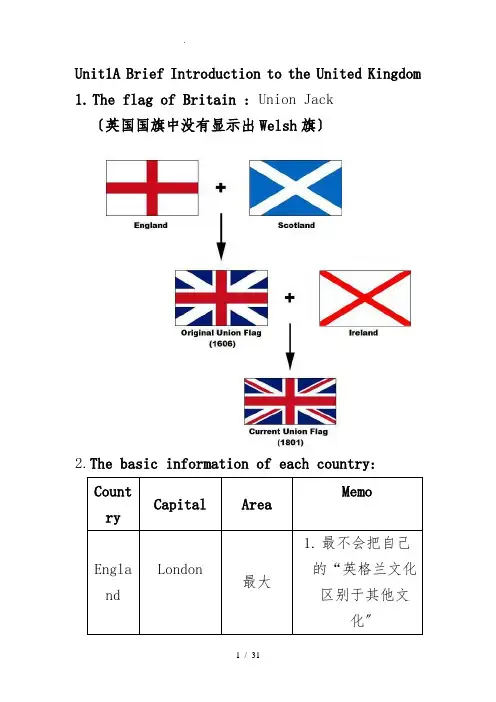
Unit1A Brief Introduction to the United Kingdom 1.The flag of Britain : Union Jack〔英国国旗中没有显示出Welsh旗〕2.The basic information of each country:Count ry Capital AreaMemoEngla nd London最大1.最不会把自己的“英格兰文化区别于其他文化〞3.The time joining the British parliament: However, in 1707 by agreement of the English and Scottish parliaments, Scotland joined the Union.4.Difference between the British Isles ,UK, Great Britain , and England:●British Isles:the island of Great Britainthe island of Irelandsurrounding isles●UK=Great Britain + Northern Ireland●Great Britain =England +Scotland + Wales5.The four major invasions in the history of Great Britain :At first, England was occupied by Celtic people. Then in 43AD Britain was invaded by the Roman Empire.Result: England and Wales became a part of the Roman Empire for nearly 400 years.the Angle-Saxon invaded.Result: The land they lived became" Angle-land",later changed into England, the language they spoken became English.PS:One of the best-known English legends derivesfrom this time. In 5 century AD, King Author(亚瑟王) united the British, and with his magical sword, Excalibur〔被称为“王者之剑〞的圣剑〕, drove the Saxons back.关于亚瑟王的一些名词:Excalibur:被称为“王者之剑〞的圣剑;亚瑟王之魔剑Castle at Tintagel(廷塔杰尔) in Cornwall: Tintagel传说为亚瑟王的诞生地,这是一个与亚瑟王传奇有关的地方。
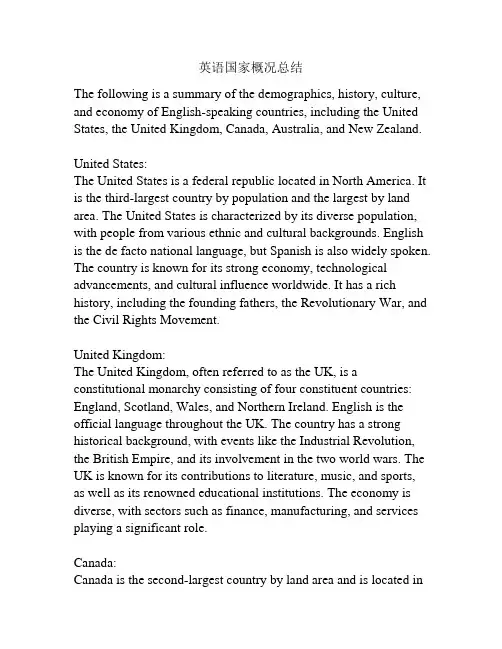
英语国家概况总结The following is a summary of the demographics, history, culture, and economy of English-speaking countries, including the United States, the United Kingdom, Canada, Australia, and New Zealand. United States:The United States is a federal republic located in North America. It is the third-largest country by population and the largest by land area. The United States is characterized by its diverse population, with people from various ethnic and cultural backgrounds. English is the de facto national language, but Spanish is also widely spoken. The country is known for its strong economy, technological advancements, and cultural influence worldwide. It has a rich history, including the founding fathers, the Revolutionary War, and the Civil Rights Movement.United Kingdom:The United Kingdom, often referred to as the UK, is a constitutional monarchy consisting of four constituent countries: England, Scotland, Wales, and Northern Ireland. English is the official language throughout the UK. The country has a strong historical background, with events like the Industrial Revolution, the British Empire, and its involvement in the two world wars. The UK is known for its contributions to literature, music, and sports, as well as its renowned educational institutions. The economy is diverse, with sectors such as finance, manufacturing, and services playing a significant role.Canada:Canada is the second-largest country by land area and is located inNorth America. It is a parliamentary democracy and a constitutional monarchy, with English and French as its official languages. Canada is known for its multiculturalism and diversity, with immigrants from all over the world settling in the country. The economy is highly developed, with industries such as natural resources, manufacturing, and technology contributing significantly. Canada has a rich indigenous history and unique cultural heritage, including the Inuit, First Nations, and Métis peoples.Australia:Australia is both a country and a continent located in the Southern Hemisphere. It is the world's sixth-largest country by land area. English is the official language, and Australia has a diverse multicultural society, influenced by its history of immigration from different parts of the world. The country has a strong economy, with sectors such as mining, agriculture, tourism, and education contributing significantly. Australia is known for its beautiful landscapes, unique wildlife, and vibrant cities like Sydney and Melbourne.New Zealand:New Zealand is an island country located in the southwestern Pacific Ocean. It is made up of two main islands, the North Island and the South Island, as well as several smaller islands. English and Māori are official languages in New Zealand. The country has a rich in digenous Māori culture, and its stunning landscapes, including mountains, lakes, and fjords, attract tourists from around the world. New Zealand has a stable economy, with sectors such as agriculture, tourism, and international education contributingsignificantly. It is known for adventure sports, such as bungee jumping and hiking.In conclusion, English-speaking countries, including the United States, the United Kingdom, Canada, Australia, and New Zealand, are diverse and culturally rich nations with strong economies and a significant global influence. Each country has its unique history, culture, and natural beauty, making them attractive destinations for people from all over the world.。
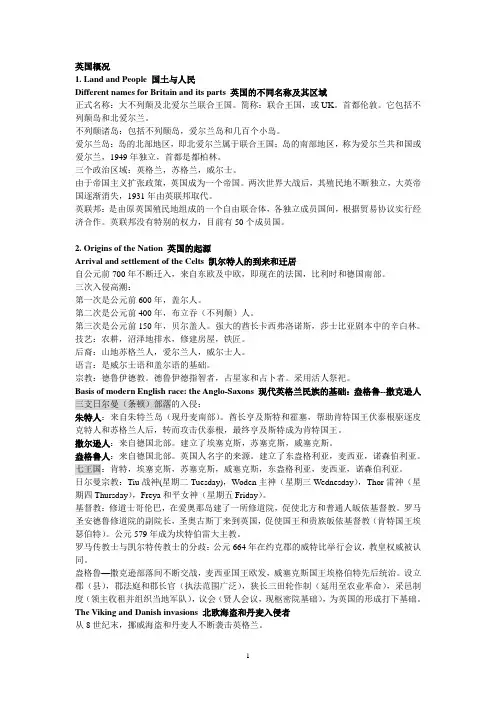
英国概况1. Land and People 国土与人民Different names for Britain and its parts 英国的不同名称及其区域正式名称:大不列颠及北爱尔兰联合王国。
简称:联合王国,或UK。
首都伦敦。
它包括不列颠岛和北爱尔兰。
不列颠诸岛:包括不列颠岛,爱尔兰岛和几百个小岛。
爱尔兰岛:岛的北部地区,即北爱尔兰属于联合王国;岛的南部地区,称为爱尔兰共和国或爱尔兰,1949年独立,首都是都柏林。
三个政治区域:英格兰,苏格兰,威尔士。
由于帝国主义扩张政策,英国成为一个帝国。
两次世界大战后,其殖民地不断独立,大英帝国逐渐消失,1931年由英联邦取代。
英联邦:是由原英国殖民地组成的一个自由联合体,各独立成员国间,根据贸易协议实行经济合作。
英联邦没有特别的权力,目前有50个成员国。
2. Origins of the Nation 英国的起源Arrival and settlement of the Celts 凯尔特人的到来和迁居自公元前700年不断迁入,来自东欧及中欧,即现在的法国,比利时和德国南部。
三次入侵高潮:第一次是公元前600年,盖尔人。
第二次是公元前400年,布立吞(不列颠)人。
第三次是公元前150年,贝尔盖人。
强大的酋长卡西弗洛诺斯,莎士比亚剧本中的辛白林。
技艺:农耕,沼泽地排水,修建房屋,铁匠。
后裔:山地苏格兰人,爱尔兰人,威尔士人。
语言:是威尔士语和盖尔语的基础。
宗教:德鲁伊德教。
德鲁伊德指智者,占星家和占卜者。
采用活人祭祀。
Basis of modern English race: the Anglo-Saxons 现代英格兰民族的基础:盎格鲁--撒克逊人三支日尔曼(条顿)部落的入侵:朱特人:来自朱特兰岛(现丹麦南部)。
酋长亨及斯特和霍塞,帮助肯特国王伏泰根驱逐皮克特人和苏格兰人后,转而攻击伏泰根,最终亨及斯特成为肯特国王。
撒尔逊人:来自德国北部。
建立了埃塞克斯,苏塞克斯,威塞克斯。
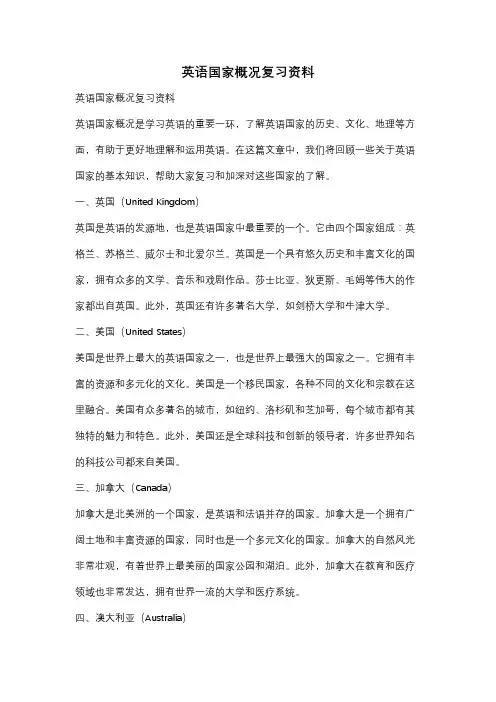
英语国家概况复习资料英语国家概况复习资料英语国家概况是学习英语的重要一环,了解英语国家的历史、文化、地理等方面,有助于更好地理解和运用英语。
在这篇文章中,我们将回顾一些关于英语国家的基本知识,帮助大家复习和加深对这些国家的了解。
一、英国(United Kingdom)英国是英语的发源地,也是英语国家中最重要的一个。
它由四个国家组成:英格兰、苏格兰、威尔士和北爱尔兰。
英国是一个具有悠久历史和丰富文化的国家,拥有众多的文学、音乐和戏剧作品。
莎士比亚、狄更斯、毛姆等伟大的作家都出自英国。
此外,英国还有许多著名大学,如剑桥大学和牛津大学。
二、美国(United States)美国是世界上最大的英语国家之一,也是世界上最强大的国家之一。
它拥有丰富的资源和多元化的文化。
美国是一个移民国家,各种不同的文化和宗教在这里融合。
美国有众多著名的城市,如纽约、洛杉矶和芝加哥,每个城市都有其独特的魅力和特色。
此外,美国还是全球科技和创新的领导者,许多世界知名的科技公司都来自美国。
三、加拿大(Canada)加拿大是北美洲的一个国家,是英语和法语并存的国家。
加拿大是一个拥有广阔土地和丰富资源的国家,同时也是一个多元文化的国家。
加拿大的自然风光非常壮观,有着世界上最美丽的国家公园和湖泊。
此外,加拿大在教育和医疗领域也非常发达,拥有世界一流的大学和医疗系统。
四、澳大利亚(Australia)澳大利亚是一个位于南半球的国家,也是一个英语国家。
澳大利亚拥有宽广的土地和独特的动植物资源,是世界上最大的岛屿国家。
澳大利亚的自然环境非常独特,有着世界上最壮观的珊瑚礁和大堡礁。
此外,澳大利亚还以其高质量的教育和研究机构而闻名,吸引着来自世界各地的留学生。
五、新西兰(New Zealand)新西兰是一个位于南太平洋的岛国,也是一个英语国家。
新西兰的自然环境非常优美,有着壮丽的山脉、湖泊和海岸线。
新西兰是一个农业和旅游业发达的国家,其乳制品和葡萄酒在世界上享有盛誉。
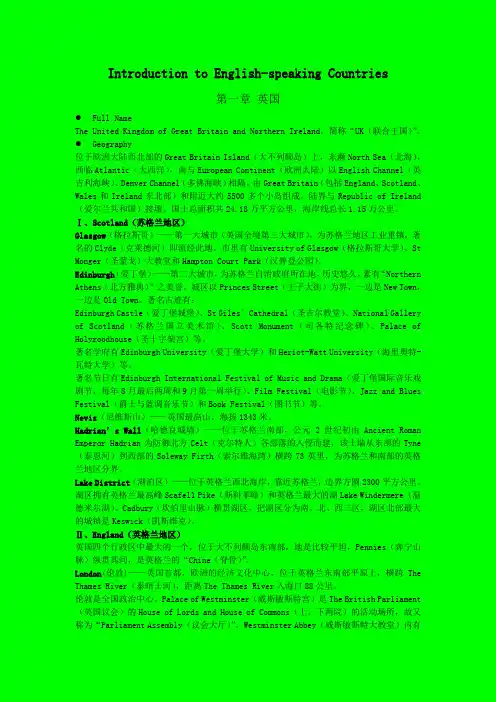
Introduction to English-speaking Countries第一章英国●Full NameThe United Kingdom of Great Britain and Northern Ireland,简称“UK(联合王国)”。
●Geography位于欧洲大陆西北部的Great Britain Island(大不列颠岛)上,东濒North Sea(北海),西临Atlantic(大西洋),南与European Continent(欧洲大陆)以English Channel(英吉利海峡)、Denver Channel(多佛海峡)相隔。
由Great Britain(包括England、Scotland、Wales和Ireland东北部)和附近大约5500多个小岛组成。
陆界与Republic of Ireland (爱尔兰共和国)接壤。
国土总面积共24.18万平方公里,海岸线总长1.15万公里。
Ⅰ、Scotland(苏格兰地区)Glasgow(格拉斯哥)——第一大城市(英国全境第三大城市),为苏格兰地区工业重镇,著名的Clyde(克莱德河)即流经此地。
市里有University of Glasgow(格拉斯哥大学)、St Monger(圣蒙戈)大教堂和Hampton Court Park(汉普登公园)。
Edinburgh(爱丁堡)——第二大城市,为苏格兰自治政府所在地,历史悠久,素有“Northern Athens(北方雅典)”之美誉。
城区以Princes Street(王子大街)为界,一边是New Town,一边是Old Town。
著名古迹有:Edinburgh Castle(爱丁堡城堡)、St Giles′Cathedral(圣吉尔教堂)、National Gallery of Scotland(苏格兰国立美术馆)、Scott Monument(司各特纪念碑)、Palace of Holyroodhouse(圣十字架宫)等。
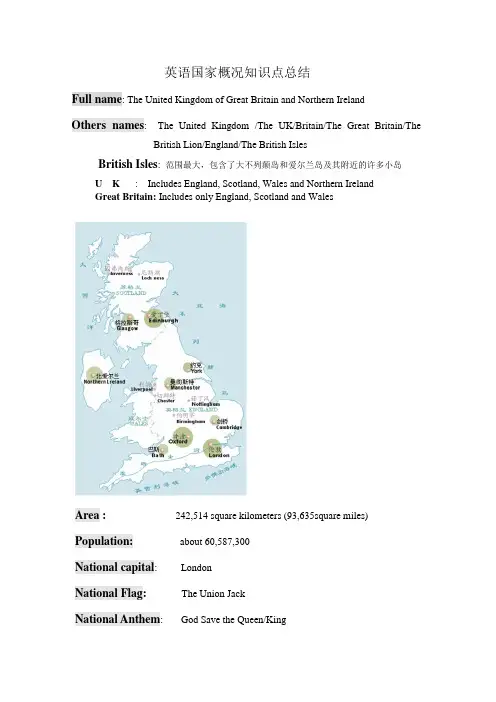
英语国家概况知识点总结Full name: The United Kingdom of Great Britain and Northern IrelandOthers names: The United Kingdom /The UK/Britain/The Great Britain/The British Lion/England/The British IslesBritish Isles: 范围最大,包含了大不列颠岛和爱尔兰岛及其附近的许多小岛U K : Includes England, Scotland, Wales and Northern IrelandGreat Britain: Includes only England, Scotland and WalesArea : 242,514 square kilometers (93,635square miles) Population: about 60,587,300National capital: LondonNational Flag: The Union JackNational Anthem: God Save the Queen/KingComponents:England:1.The largest and the most populated country of UK. It occupies more thanhalf the island of Great Britain.2.Area: 130,281 square kilometers (53.7 percent)3. Population: 50,762,900(83.8 percent) 401 people per square kilo4. Capital: London (the seat of government, center of business, the heart of artsand culture, dominates England just like England dominates TheUK)Scotland:1.The second largest of the four nations both in area and population .no longerhas a separate legislature and executive, and its economy is integrated intothat of the rest of Britain. But it does have a separate administration,different legal and educational systems as well as its Presbyterian nationalchurch. Above all it has retained much of its distinct cultural identity.2.area: 77,925 square kilometers(32.1 percent)3.population: 5,116,900 (8.4persent) 65 people per square kilo4.capital: Edinburgh (on the east cost represent the capital of theregion)5.the l argest city is Glasgow (In the west)Wales:1. A peninsular jutting from England into the Irish Sea, and is the smallestamong the three nations on the island of Britain. And has been dominated byEngland for longer period than the other three nations since its officiallyunion with England in 1536(actually England has ruled Wales in 1343 butnot officially recognized)2.area: 20732 square kilometers (8.5percent)3.population: 2,965,900(4.9persent) 142 people per square kilo4.capital: Cardiff (southern Wales) serving as an important seaport andindustrial center5.Wales retained a unique cultural social and economic development,notably its national language, Welsh, and a devolved Welsh Assembly Northern Ireland:1.Often referred to as the province of Ulster, is part of the island Ireland locatedin its northeast corner. And is the smallest both in area and population among the four nations of the UK.2.area: 13,576square kilometers (5.7 percent of the UK and one six of the islandof Ireland )3.population:1,741,600(2.9 percent)4.capital:Belfast (a seaport on the east cost , is a center of shipbuilding andlinen textiles and it created the Titanic)5.。

英语国家概况笔记整理英语国家概况笔记整理英语国家是指以英语为官方语言或为第一语言的国家。
这些国家有着丰富的历史和文化,并且在全球范围内都有着重要的地位。
以下是对一些典型英语国家的笔记整理。
英格兰英格兰是指大不列颠岛上最大的一个国家,首都是伦敦。
英格兰是全球最重要的文化和商业中心之一,是世界上最重要的旅游胜地之一。
它以其壮丽的城市风光、古老的大学、世界顶级艺术品和丰富的文化遗产而著名。
英格兰还是口音最标准、最古老的英语发源地之一。
苏格兰苏格兰是英国的一个国家,位于英国北部,与英格兰隔着哈德里安长城相隔。
苏格兰地处北极圈附近,因此气候较为寒冷,但是其美丽的山川湖泊和独特的文化使得它成为了一个重要的旅游胜地。
苏格兰的联合王国象征是印有一只独角兽的盾牌。
苏格兰有着悠久的历史,并且拥有着独特的文化,比如苏格兰传统的音乐、服装和食品等。
威尔士威尔士是英国的一个国家,位于英格兰西部。
它以其壮观的山地风景和世界最佳的海岸线而著名。
威尔士人喜欢庆祝传统文化,并且其歌曲、舞蹈和风俗仍然在今天得到了广泛传承。
威尔士听起来有着特别的口音。
英国国旗上的红色龙即是威尔士的象征。
爱尔兰爱尔兰是一个欧洲国家,位于大不列颠岛西侧。
它分为爱尔兰共和国和北爱尔兰,后者是英国的一部分。
爱尔兰是一个美丽的国家,拥有许多独特的风景和文化遗产。
爱尔兰以其友好的人民、美妙的音乐和优美的文学而著名。
美国美国是世界上最强大的国家之一,是一个多元化的国家,拥有许多文化和民族。
美国以其灿烂多彩的文化、科技创新和政治制度而闻名于世。
美国是一个旅游胜地,拥有世界上最知名的城市之一,如纽约、洛杉矶和旧金山等。
在美国,许多地方需要汽车来进行通行,而且美国人也对汽车有着独特的热爱。
加拿大加拿大是北美洲最多元化和最友善的国家之一。
加拿大有着尽可能保持自然美和野生动物保护的承诺,拥有美丽的大自然风光,如落基山脉和尼亚加拉瀑布。
加拿大人民非常注重公民权利和社会公正,是全世界人权保护能见度最高的国家之一。
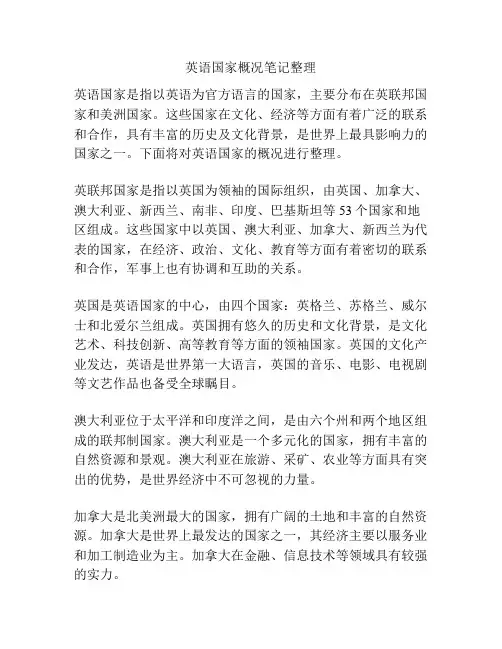
英语国家概况笔记整理英语国家是指以英语为官方语言的国家,主要分布在英联邦国家和美洲国家。
这些国家在文化、经济等方面有着广泛的联系和合作,具有丰富的历史及文化背景,是世界上最具影响力的国家之一。
下面将对英语国家的概况进行整理。
英联邦国家是指以英国为领袖的国际组织,由英国、加拿大、澳大利亚、新西兰、南非、印度、巴基斯坦等53个国家和地区组成。
这些国家中以英国、澳大利亚、加拿大、新西兰为代表的国家,在经济、政治、文化、教育等方面有着密切的联系和合作,军事上也有协调和互助的关系。
英国是英语国家的中心,由四个国家:英格兰、苏格兰、威尔士和北爱尔兰组成。
英国拥有悠久的历史和文化背景,是文化艺术、科技创新、高等教育等方面的领袖国家。
英国的文化产业发达,英语是世界第一大语言,英国的音乐、电影、电视剧等文艺作品也备受全球瞩目。
澳大利亚位于太平洋和印度洋之间,是由六个州和两个地区组成的联邦制国家。
澳大利亚是一个多元化的国家,拥有丰富的自然资源和景观。
澳大利亚在旅游、采矿、农业等方面具有突出的优势,是世界经济中不可忽视的力量。
加拿大是北美洲最大的国家,拥有广阔的土地和丰富的自然资源。
加拿大是世界上最发达的国家之一,其经济主要以服务业和加工制造业为主。
加拿大在金融、信息技术等领域具有较强的实力。
新西兰是一个位于南太平洋的岛国,由北岛和南岛以及其他一些小岛组成。
新西兰优美的自然环境使其成为了世界上著名的旅游胜地,同时其在农业、林业、渔业等领域也有着不俗的表现。
美洲国家是指以英语为官方语言的南、北美洲国家,包括美国、加拿大和13个加勒比国家。
这些国家在经济、政治、文化等方面也有着紧密的联系和合作。
美国是世界经济最大的国家之一,是世界级的大国和超级大国。
美国拥有强大的军事实力和文化影响力,同时也在国际事务中发挥着重要作用。
美国是全球科技、金融和文化中心之一,其在电影、音乐、时尚、饮食等方面也有着巨大的影响力。
加勒比国家是指坐落在加勒比海与墨西哥湾之间的一批岛国,其中比较著名的包括牙买加、海地、巴哈马等。

英语国家概况复习整理英语国家概况一、国家概况英语是世界上使用最广泛的第二语言,几乎所有英语国家都以英语为官方语言。
以下是几个代表性的英语国家概况:1. 英国(United Kingdom)英国位于欧洲大陆的西北部,由四个国家组成:英格兰、苏格兰、威尔士和北爱尔兰。
英国是一个君主立宪制国家,伦敦是其首都和最大城市。
英国是工业革命的发源地之一,对现代科学、文化和法律产生了重要影响。
2. 美国(United States)美国是一个位于北美洲的联邦共和制国家,由50个州组成。
华盛顿特区是其首都,纽约市是最大城市。
美国是世界上最大的经济体和军事力量之一,对全球政治、经济和文化具有巨大影响。
3. 加拿大(Canada)加拿大是北美洲最北端的国家,是一个君主立宪制国家。
渥太华是其首都,多伦多是最大城市。
加拿大是世界上最大的国家之一,拥有丰富的自然资源和文化多样性。
4. 澳大利亚(Australia)澳大利亚是世界上面积第六大的国家,位于南太平洋地区。
堪培拉是其首都,悉尼是最大城市。
澳大利亚以其独特的自然景观、丰富的动植物种类和多元文化而闻名。
5. 新西兰(New Zealand)新西兰位于南太平洋地区,由北岛和南岛组成。
惠灵顿是其首都,奥克兰是最大城市。
新西兰以其美丽的自然景观和友好的人民而闻名,是旅游和冒险活动的热门目的地。
二、国家特点1. 文化和历史英语国家的文化和历史各具特色。
英国的文化底蕴深厚,有着悠久的王室传统和文学艺术遗产。
美国是一个移民国家,融合了来自世界各地的文化,拥有独特的美国梦和好莱坞电影文化。
加拿大和澳大利亚等英联邦国家也保留了英国文化的一些传统,并发展了自己的多元文化。
2. 经济和科技英语国家在经济和科技领域具有强大实力。
英国在金融、教育、文化创意产业等领域发达,是世界上最重要的金融中心之一。
美国是全球最大的市场之一,科技创新领域具有很高的竞争力。
加拿大和澳大利亚等国也在自然资源开发和高科技产业方面表现出色。
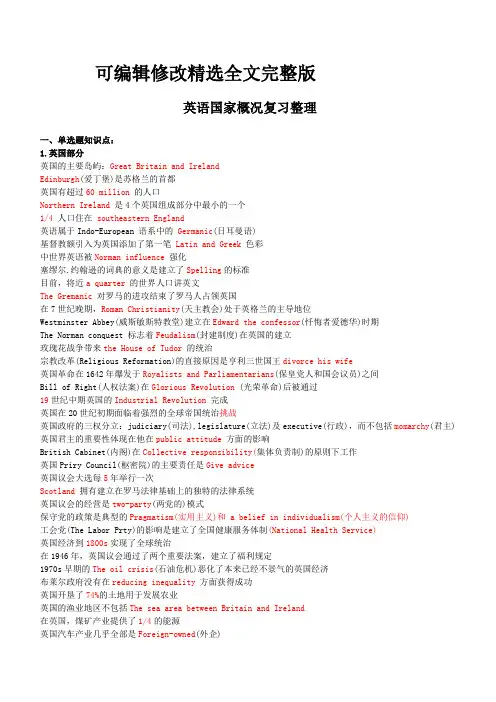
可编辑修改精选全文完整版英语国家概况复习整理一、单选题知识点:1.英国部分英国的主要岛屿:Great Britain and IrelandEdinburgh(爱丁堡)是苏格兰的首都英国有超过60 million的人口Northern Ireland是4个英国组成部分中最小的一个1/4 人口住在southeastern England英语属于Indo-European 语系中的Germanic(日耳曼语)基督教额引入为英国添加了第一笔 Latin and Greek色彩中世界英语被Norman influence强化塞缪尔.约翰逊的词典的意义是建立了Spelling的标准目前,将近a quarter的世界人口讲英文The Gremanic对罗马的进攻结束了罗马人占领英国在7世纪晚期,Roman Christianity(天主教会)处于英格兰的主导地位Westminster Abbey(威斯敏斯特教堂)建立在Edward the confessor(忏悔者爱德华)时期The Norman conquest 标志着Feudalism(封建制度)在英国的建立玫瑰花战争带来the House of Tudor的统治宗教改革(Religious Reformation)的直接原因是亨利三世国王divorce his wife英国革命在1642年爆发于Royalists and Parliamentarians(保皇党人和国会议员)之间Bill of Right(人权法案)在Glorious Revolution (光荣革命)后被通过19世纪中期英国的Industrial Revolution完成英国在20世纪初期面临着强烈的全球帝国统治挑战英国政府的三权分立:judiciary(司法),legislature(立法)及executive(行政),而不包括momarchy(君主) 英国君主的重要性体现在他在public attitude方面的影响British Cabinet(内阁)在Collective responsibility(集体负责制)的原则下工作英国Priry Council(枢密院)的主要责任是Give advice英国议会大选每5年举行一次Scotland拥有建立在罗马法律基础上的独特的法律系统英国议会的经营是two-party(两党的)模式保守党的政策是典型的Pragmatism(实用主义)和 a belief in individualism(个人主义的信仰)工会党(The Labor Prty)的影响是建立了全国健康服务体制(National Health Service)英国经济到1800s实现了全球统治在1946年,英国议会通过了两个重要法案,建立了福利规定1970s早期的The oil crisis(石油危机)恶化了本来已经不景气的英国经济布莱尔政府没有在reducing inequality方面获得成功英国开垦了74%的土地用于发展农业英国的渔业地区不包括The sea area between Britain and Ireland在英国,煤矿产业提供了1/4的能源英国汽车产业几乎全部是Foreign-owned(外企)英国文艺复兴时期最光辉的成就是drama(戏剧)"Preface to Lyrical Ballads"是浪漫诗的开篇之作Thomas Hardy 是19世纪批判现实主义的代表Waiting for Godot是Samuel Bekett 写的2.美国部分美国大陆上有48个statesAlaska是最大的州美国在 central North America ,加拿大在它的北面,墨西哥在南面,大西洋在它的东面,太平洋在它的西面美国最大的河流是Mississippi River哈佛、耶鲁和MIT等著名大学位于New EnglandNiagara Falls(尼亚加拉瀑布)位于美国-加拿大边境上阿拉斯加人口中没有the Blacks美国最大的少数民族是the Blacks1924年的移民法案限制美国的进一步移民,尤其是来自欧洲的美国文化主流的特点是:English-speaking,Western European,Protestant and Middle-class第一个北美殖民地建立在Jamestorn,VirginiaPilrim Fathers 是一群Paritans(清教徒),他们为了逃避在英国的迫害而来到美国7年战争发生在French and British之间"No taxation without represtation"是The people of 13 colonies的口号美国独立战争的第一枪在Lexingto (列克星顿)打响1775年5月,The second continenta congrsee 在Philadelphia举行林肯签发了Declaration of Independence承诺给予所以奴隶自由第二次世界大战开始时,美国是neutrality(中立的)政策Roosevelt(罗斯福)新政处理了大萧条的问题越南战争继续受Eisenhower,kennedy and johnson的影响美国的ore(矿石)只占世界很小部分现代美国经济经历了faming economy,handcraft economy,最终形成industrial economy第一家国家银行是在Alexander Hamilton时期建立的美国1/3粮食用于出口目前,美国出口占世界10%美国常规教育包括elementary,secondary and higher education美国高等教育开始于Harvard University 的建立MIT没有出过总统美国国庆节在July 4thWashington Irving 是美国文学之父Tony Morrison是第一个获得诺贝尔奖文学奖的非裔美国人二、名词解释:1. American Civil War(美国内战)American Civil War is a war that was fought in the US between 1861 and 1865 when 11 southern states rebelled against the federal government. The southern states were beaten, and as a result of the war, slaves became free.2.Melting pot and salad(大熔炉)The melting pot is an analogy for the way in which homogeneous societies develop, in which the ingredients in the pot (people of different cultures, races and religions) are combined so as to develop a multi-ethnic society. The term, which originates from the United States, is often used to describe societies experiencing large scale immigration from many different countries.3.American Constitution(美国宪法)American Constitution,which was drawn up in 1787 and came into effect in 1789,is the basic law of the land.For over two centuries,it has guided the development of government institution and has the basis for the nation,s political stability,economic growth and social progress.4.Cold War(冷战)In the spring of 1947 ,for the purpose of establishing the U.S.hegenmiony(霸权) in postwar world,President Truman declared the "Tueman Doctrine",aiming at expanding American sphere of influence.This marked the beginning of the Cold War period.the Cold War exerted great influence in Europe,and two Germanys were founded.Then,in April 1949,the U.S.allied with other Western countries,forming the North Atlantic Treaty Organization.While seeking to prevent Communist ideology from gaining further adherents(追随者) in Europe, the U.S.also responded to the challenges elsewhere.5.Thanksgiving(感恩节)Thanksgiving is a associated with the time when Europeans first came to the New World.In1620,the Mayflower arrived and brought about 150 Pilgrims.Life at the beginning was very hard and there was not enough food,so many of them died.During the following summer the Native Americans helped them and then they had a bountiful harvest.So they held a big celebration to thank God and the Native Americans.6.British Labor Party(英国工会党)British Labor Party known as a party of high taxation,was created by the growing trade union movement at the end of the 19th century.It quickly replaced the Liberal Party as one of the two largest political parties.The Labor government that come to power in 1945 had a major effort on British society. It set up the National Health Service.The party activities are largely funded by the trade unions.7.British Conservative Party(英国保守党)By and large, the Conservative Party is supported by those who have something to "conserve".Economically,the Conservative Party supports free enterprise and privatization of state-owned enterprise.It is against too much government intervention,especially nationalization.The Conservative Partyfavors reducing the influence of trade unions and minimizing expenditures on social welfare.Its policies are charactized by pragmatism and a belied in individualism.monwealth of Nations(联邦国家)The Commonwealth of Nations is a voluntary association of independent sovereign statse,all of which acknowledge the British monarch as the head.The Commonwealth is not a political union of any sort,and its member states have full autonomy to manage their internal and external affairs.It is primarily an organization in which countries with diverse economic backgrounds have an opportunity for close and equal interaction after gaining independence.The major activities of the Commonwealth are designed to advocate democracy,human rights,and to promote economic cooperation and growth within its members.9.Critical Realism(批判现实主义)The Critical Realism of the 19th centry flourished in the 1840s and the early 1850s.The Critical Realism described the chief traits of the society and criticized the capitalist system from a democratic viewpoint.The greatest English realist was Charles Dickens.10.Standard English (标准英语)Standard English is based on the speech of the upper class of southeastern England.It is widely used in media and taught at school .It is preferred by the educated,middle-class people .It has developed and has been promoted as a model for correct British English .It is also the norm carried overseas.Today Standard English is codified to the extent that the grammar and vocabulary are much the same everywhere in the world where English is thought and used.三、简答题:1.what is the full name of the UK?The full name is the United Kingdom of Great Britain and Northern Ireland2.why do tourists from all over the world like to go to Scotland?They like to enjoy the beautiful Scottish scenery ,to drink Scotch whisky and to see Scotsmen wearing kilts and playing bagpipes.3.How many periods can the development of the English language be divided into and what are they ?The development of the English language can be divided into three periods : Old English ,Middle English and Modern English.4.Why did English become more important after the Black Death?The laboring and merchant classes grew in economic and social importance after the Black Death,so English also grew in importance compare to French.。
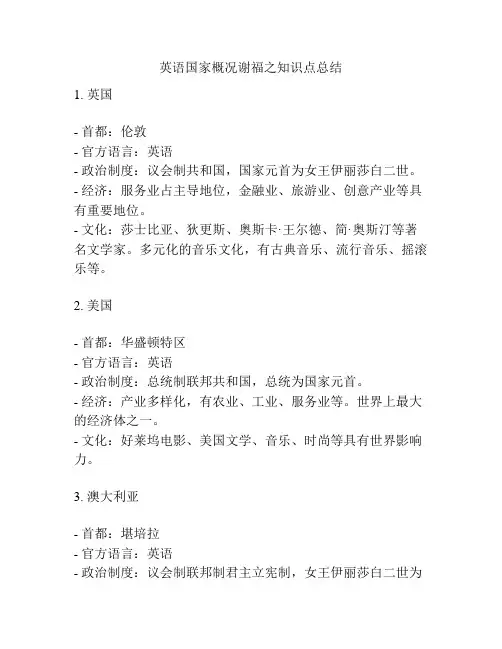
英语国家概况谢福之知识点总结1. 英国- 首都:伦敦- 官方语言:英语- 政治制度:议会制共和国,国家元首为女王伊丽莎白二世。
- 经济:服务业占主导地位,金融业、旅游业、创意产业等具有重要地位。
- 文化:莎士比亚、狄更斯、奥斯卡·王尔德、简·奥斯汀等著名文学家。
多元化的音乐文化,有古典音乐、流行音乐、摇滚乐等。
2. 美国- 首都:华盛顿特区- 官方语言:英语- 政治制度:总统制联邦共和国,总统为国家元首。
- 经济:产业多样化,有农业、工业、服务业等。
世界上最大的经济体之一。
- 文化:好莱坞电影、美国文学、音乐、时尚等具有世界影响力。
3. 澳大利亚- 首都:堪培拉- 官方语言:英语- 政治制度:议会制联邦制君主立宪制,女王伊丽莎白二世为国家元首。
- 经济:服务业是主要产业,同时还有矿业、农业、制造业等。
- 文化:澳大利亚文学、电影、音乐、美食等具有独特风格。
4. 加拿大- 首都:渥太华- 官方语言:英语、法语- 政治制度:议会制联邦制君主立宪制,女王伊丽莎白二世为国家元首。
- 经济:移民国家,有制造业、自然资源开发、服务业等产业。
- 文化:加拿大文学、电影、音乐、美食等具有多元化和包容性。
5. 新西兰- 首都:惠灵顿- 官方语言:英语、毛利语- 政治制度:议会制君主立宪制,女王伊丽莎白二世为国家元首。
- 经济:服务业占主导地位,同时还有农业、林业、制造业等产业。
- 文化:毛利文化、新西兰电影、音乐、户外活动等具有独特特色。
英语国家概况(An Overview ofEnglishSpeaking Countries)一、英国(United Kingdom)1. 地理位置:英国位于欧洲大陆的西北边缘,由大不列颠岛、北爱尔兰和若干小岛组成。
2. 首都:伦敦(London),是英国的政治、经济、文化和交通中心。
3. 官方语言:英语4. 人口:约6600万,其中英格兰占最大比例。
5. 国旗:英国国旗被称为“米字旗”,由蓝、白、红三种颜色组成。
6. 经济:英国是世界上发达国家之一,拥有强大的金融、工业和科技实力。
7. 教育体系:英国教育体系享誉世界,牛津、剑桥等世界知名学府坐落于此。
8. 文化特色:英国有着丰富的历史文化底蕴,如莎士比亚、牛顿、披头士乐队等均诞生于此。
同时,英国也是现代足球的发源地。
二、美国(United States of America)1. 地理位置:美国位于北美洲,东临大西洋,西濒太平洋,南接墨西哥湾和加勒比海,北邻加拿大。
2. 首都:华盛顿特区(Washington, D.C.),是美国政治中心。
3. 官方语言:英语4. 人口:约3.3亿,是世界上第三人口大国。
5. 国旗:美国国旗被称为“星条旗”,由红、白、蓝三种颜色组成。
6. 经济:美国是全球最大的经济体,拥有强大的科技创新能力和金融市场。
7. 教育体系:美国教育资源丰富,世界顶尖大学如哈佛、斯坦福等均位于此。
8. 文化特色:美国文化多元化,涵盖了欧洲、亚洲、非洲等多种文化元素。
好莱坞电影、NBA篮球、美式足球等在全球具有广泛影响力。
三、加拿大(Canada)1. 地理位置:加拿大位于北美洲北部,东临大西洋,西濒太平洋,北接北冰洋,南邻美国。
2. 首都:渥太华(Ottawa),是加拿大的政治中心。
3. 官方语言:英语和法语4. 人口:约3800万,是世界上面积第二大国家。
5. 国旗:加拿大国旗被称为“枫叶旗”,由红、白两色组成。
6. 经济:加拿大经济发达,资源丰富,特别是石油、天然气和矿产资源。
Chapter 1 Land and People一、本章知识点1.重点:重点: ① Different names for Britain and its parts 2.难点、考点:难点、考点: ① Britain‘s official name ② British Commonwealth 三、课本内容(一)Different names for Britain and its parts Strictly speaking, the British Isles, Great Britain and England are all geographical names. 1. The British Isles are made up of two large islands and hundreds of small islands. (see map of UK ) The two large islands are Great Britain and Ireland. Great Britain is the larger of these two islands. 2. ★The official name of the United Kingdom isthe United Kingdom of Great Britain and Northern Ireland . But it is too much of a mouthful to say such a long name for a country, so people just say Britain, the United Kingdom or simply U.K. (UK ) capital: London The Republic of Ireland 爱尔兰共和国爱尔兰共和国 has been an independent republic since 1949 and its capital is Dublin . 3. There are three political divisions on the island of Great Britain: on the island of Great Britain: England, Scotland, and Wales . England is the largest, most . England is the largest, most populous and richest, so people tend to use ―Englandǁ and ―Englishǁ when they mean ―Britainǁ and ―Britishǁ. 4. The British Empire 大英帝国: one fourth of th e world‘s people a nd and one fourth of the world‘s land area.5. The British Empire gradually disappeared and it was replaced by the British Commonwealth or the Commonwealth of Nations in 1931. ★The Commonwealth is a free association of independent countries that were once colonies of Britain. Member nations are joined together economically and have certain trading arrangements. The Commonwealth has no special powers. The decision to become a member of the Commonwealth is left to each nation.如果出简答,则只需要第一句话.(二)Others Geographical Features 1. The United Kingdom is separated from the rest of Europe by the English Channel in the south and the North Sea in the east. The English Channel lies between Britain and France . (p.4)T aiwan Strait :台湾海峡:台湾海峡2. ―Chunnel ǁ: channel + tunnel, opened to traffic in 1994. (p.5)Smog: smoke +fog Mortel: motor +hotel Kidult: kid +adult 3. The highest mountain in Britain: Ben Nevis , 1,343m in Scotland. (p.6)The longest river: t he Severn River the Severn River (338 km )The second largest and most important river: the Thames River (336 km ) (p.7)4. 90% of the population is urban and only 10% is rural. (p.11)5. The English are Anglo-Saxons Anglo-Saxons 盎格鲁撒克逊人, but the Scots, Welsh and Irish are Celts 凯尔特人. (p.12) 四、总结 ① Britain‘s official nam e ② British Commonwealth Chapter 2 The Origins of a Nation (5000 BC – AD 1066)一、本章知识点1.重点:① Arrival and settlement of the Celts ② Basis of modern English race: the Anglo-Saxons ③ The Viking and Danish invasions ④ King Alfred and his contributions ⑤ The Norman Conquest and its consequences 2.难点、考点:① the Anglo-Saxons: Heptarchy 七王国; foundation of the English state ② King Alfred ③ Norman Conquest 三、课本内容(一)Arrival and settlement of the Celts (p.17)1. began to arrive about 700 BC2. originally have come from eastern and central Europe, now France, Belgium and southern Germany3. three main waves ——————11st . Gaels 盖尔人, about 600 BC; 2nd . Brythons 布列吞人, 400 BC, (Britain ); 3rd . Belgae 比利其人, 150 BC, (Belgium ). Gaelic :盖尔语:盖尔语4. The Celtic tribes are ancestors of Highland Scots, the Irish and the Welsh, and their languages are the basis of both Welsh and Gaelic. 5. Religion: D ruidism Druidism : The C elts‘ religion was Druidism. The Druids worshipped and performed their rites in woods by the light of Celts‘ religion was Druidism. The Druids worshipped and performed their rites in woods by the light of the moon. 6. Roman Britain (55 BC – AD 410) p.18: British recorded history begins with the Roman invasion . For nearly . For nearly 400400 years Britain was under the Roman occupation. The Roman capital was London (Londinium ). (二)Basis of modern English race: the Anglo-Saxons (p.20-23)1. mid-5th century, three Teutonic tribes: Jutes 朱特人 (from southern Denmark ), Saxons , and Angles (both from northern Germany ); Angles were to give their name to the English people.2. ★Heptarchy 七王国————seven principal kingdoms set up by the Anglo-Saxons: seven principal kingdoms set up by the Anglo-Saxons: Kent, Essex, Sussex, Wessex, East Anglia, Marcia and Northumbria. (英国版的战国七雄)Monarchy :君主制The Anglo-Saxon tribes 部落部落 were constantly at war with one another, each trying to get the upper hand, so that the kingdoms were often broken up and often pieced together again. 3. In 829, Egbert 伯特became an overlord of all the English. 4. T eutonic 日耳曼人的日耳曼人的 religion: Tiu religion: Tiu——war, Woden war, Woden——heaven, Thor —Storms, Freya —Peace 5. St. Augustine 奥古斯丁—— the first Archbishop of Canterbury.坎特伯雷大教主坎特伯雷大教主6. ★Anglo-Saxons laid the foundations of the English state : divide the country into shires (郡), later counties; the narrow-strip, three-field farming system (三田轮作); manorial 庄园庄园 system; Witan (议会) (council or meeting of the wisemen, 贤人会议), the basis of the Privy Council 枢密院枢密院 which still exists today. (三)The Viking and Danish invasions (p.23-24)1. from the end of 8th century, Norwegian Vikings and Danes from Denmark 挪威海盗和丹麦人挪威海盗和丹麦人2. The Danes gained the ―Danelaw ǁ(丹麦法区), the north and east of England. 3. The Witan chose Canute, the Danish Leader, as king in 1016. Canute made England part of a Scandinavian empire.(四)King Alfred and his contributions 1. King of Wessex (871-899) (抗击北欧海盗入侵的国家英雄)2. ★his contributions : ―the father of the British navy ǁ; reorganized the f yrd fyrd 英国民兵英国民兵 (the Saxon army); translated into English Bede‘s Ecclesiastical History of the English People ; established schools and formulated a legal system. 3. ―Alfred the Greatǁ(五)The Norman Conquest and its consequences (p.24-25)1. King Edward, known as ―the Confessor ǁ, was far more Norman than Sax on 心向着诺曼第人(法国),而不是撒克逊人(英国). 2. 4 men laid claim to the English throne: the King of Norway, the Duke of Normandy, Tostig and Harold (two brothers of Edward‘s Queen ); 4人对英国有继承权,挪威国王,诺曼底公爵和爱德华国王王后的两个兄弟 3. Oct. 14, 10661066, Hastings, A nglo-Saxon England perished Anglo-Saxon England perished w ith Harold‘s death.with Harold‘s death.因为因为Harold 的死亡,英国被诺曼人打败英国被诺曼人打败4. William was crowned King of England on Christmas Day. 5. William the Conqueror: the best-known event in English history; the feudal system was completely established.法国诺曼第人征服后,威廉成为英国国王,成为英语历史最著明的事件,并且完本建立了封建制度. 四、总结: 历史上定居和入侵英国的不同民族:Celts, (Romans ) Anglo-Saxons, Viking/Dales, and Normans Chapter 3 the shaping of the nation1066-1381本章知识点本章知识点1重点: : 1 1 1 England‘s England‘s England‘s feudalism feudalism feudalism under under under the the the rule rule rule of William of William the the Conqueror Conqueror Conqueror; ; ; 2 2 2 Contents Contents Contents and and and the the the significance significance significance of of of the the the Great Charter; 3 Great Charter; 3 Origins Origins of of of the the the English English English Parliament; Parliament; Parliament; 4 4 4 The The The Hundred Hundred Hundred Years‘ War Years‘ War with with France France France and and and its consequences its consequences ; ; 5 5 5 Consequences of Consequences of the the Black Black Death; 2 难点\考点: English feudalism: Domesday book <土地清帐册>; Great Charter; English Parliament; 3课本内容课本内容i. i. England‘s feudalism under t England‘s feudalism under the rule of William the Conqueror 1. Under William, the feudal system in England was completely established. According to this system, the King owned the land personally. William gave his barons 男爵男爵 large estates in England in return for a promise of military service and a proportion of the land‘s produce.The barons parceled out 分配分配分配 land to the lesser nobles, knights and freemen, also in return for goods and services. At the bottom of the feudal scale were the villains of serfs, unfree peasants who were little better than slaves. ★Class structure 等级结构: the king ; barons-tenants-in-chief; lesser nobles, knights, and freemen; villains\serfs (补充: baron‘s oath of allegiance 誓词for the king: ―we who are as good as you swear to you, who are no better than we, to accep accept you as our king and sovereign lord provided you observe all our statutes and laws; if not, no.ǁt you as our king and sovereign lord provided you observe all our statutes and laws; if not, no.ǁ国王与贵族在封建法规所规定的权力和义务范围内平起平坐.) 2. Replace the Witan with the Grand Council (大会议) William replaced the Witan, the council of the Anglo-Saxon Kings, with the Grand Council of his new tenants-in-chief, on which they were required to serve when summoned. 3. ★Domesday Book: record of lands, tenants, and their possessions, for taxes. Not unlike the Book of Doom. (末日审判书) In order to have a reliable record of all his lands, his tenants and their possessions and to discover how much they could be called upon to pay by way of taxes, William sent his clerks to compile a property record known as Domesday Book because it seemed to the English not unlike the Book of Doom to be used by the greatest feudal lord of all on Judgment Day. 注: William took a deep interest in the development of the church in England. His policy towards the church was to keep it completely under his control, but at the same time to uphold its power. But he took care to maintain his own independence. 4. Henry Ⅱ, founder of the Plantagenet dynasty (金雀花王朝), ruled for 35 years. Henry, founder of the Angevin Dynasty, usually known as the Plantagenet dynasty, became king and went on to rule for 35 years. In Henry Ⅱ‘s reign a common law, which over -rode local law and private law, was gradually established in place of the customs of the manor which had previously varied not only from shire to shire but even from one community to another. The The common common common law law law is is is the the the unwritten unwritten unwritten law law law common common common to to to the the the whole whole whole people people people as as as distinct distinct distinct from from from law law law governing governing governing only only only sections sections sections of of of it, it, it, and and and is is ―case -madeǁ, i.e., based on precedent judgments, and derived from acknowledged custom. In Henry‘s day the jury system -whose origins can be traced to primitive trials in which witnesses were called forward to swear to the innocence of the accused-was at last replacing old English ordeals by fire and water and old Norman trials by battle. ii. contents and the significance of the Great charter 1. Crusades (十字军东征十字军东征) . The result was confrontation between king John and his barons in 1215. 2. Magna Carta, 1215 The The barons‘ charter, barons‘ charter, or or Magna Magna Magna Carta Carta Carta as as as it came it came to to be known, be known, was was presented presented presented by by by a a a delegation delegation delegation of of of their their their class class class to to to the the the king king king and and and his his advisers in the summer of 1215 at a conference at Runnymede, an island in the Thames four miles down stream from Windsor. 3. contents -63 -63 clauses: clauses: clauses: No No No tax tax tax should should should be be be made made made without without without the the the approval approval approval of of of the the the Grand Grand Grand Council; Council; Council; no no no freeman freeman freeman should should should be be be arrested, arrested, imprisoned, or deprived of his property except by the law of the land; the Church should possess all its rights, together with freedom of elections; elections; London London London and and and other other other towns towns towns should should should retain retain retain their their their ancient ancient ancient rights rights rights and and and privileges, privileges, privileges, and and and there there there should should should be be be the the the same same same weights weights weights and and measures throughout the country. Although Magna Carta has long been popularly regarded as the foundation of English liberties, it was a statement of the feudal and legal relationship between the Crown and the barons, a guarantee of the freedom of the Church and a limitation of the powers of the king. 4. significance : regarded as the foundation of English liberties; the spirit- the limitation of the powers of the king iii. o rigins of the English Parliament 1. king John and his son Henry III defied Magna Carta. The barons, under Simon de Montfort, rebelled. King john defied Magna Carta. The barons, under Simon de Montfort, Henry III‘ s brother-in-law, rebelled. 2. provisions of Oxford ----Grand Council of 24 members, half to be nominated by the barons themselves; a permanent body of advisors, without whose authority the king could not act. A civil war broke out between the king‘s support ers, mostly foreign mercenaries, and the baronial army led by Simon de Montfort. 1264 the king was defeated by De Montfort and taken prisoner. 3. ★the earliest Parliament ---- in 1265, 2 knights from each county, 2 burgesses (citizens) from each town.The Great Council developed later into the lords and the Commons known as parliament. 3. Met only by royal invitation. Its role was to offer advice. At this point parliament only met by royal invitation. Its role was to offer advice, not to make decisions. 4. under Edward I, Wales was conquered. The statute of Wales in 1284; Prince of Wales, a title held by the heir to the throne under Edward I, Henry III‘ s son, Wales was conquered (1277-1284) and came under the English Crown. The statute of Wales in 1284 placed the country under English law end Edward I presented his new-born son to the Welsh people as Prince of Wales, a title held by the heir to the throne ever since. iv. t he hundred years‘ war with France and its consequences1. the intermittent war, 1337-1453; the name is given to the intermittent war between France and England that lasted form 1337 to 1453. 2. the causes: partly territorial and partly economic 3. Edward III declared war. When Edward III (1327-1377) claimed the French Crown by right of his mother Isabella, daughter of Philip IV. In 1337 Edward declared a war that was to last for a hundred years. There were three outstanding stages of the war. 4. England was successful at first, but was defeated at last. Joan of Arc(圣女贞德) After his death in 1422, the French, encouraged by Joan of Arc, their national heroine, drove the English out of France. 5. By 1453, only Calais By 1453 Calais was the only part of France that was still in the hands of the English. 6. a blessing for both countries: good for the development of separate English and French national identity. The expulsion of the English from France is regarded as a blessing for both countries; had they remained, the superior size and wealth wealth of of of France France France would would would certainly certainly certainly have have have hindered hindered hindered the the the development development development of of of a a a separate separate separate English English English national national national identity, identity, identity, while while while French French French national national identity was hindered so long as a foreign power occupied so much French territory. V. consequences of the Black Death 1. deadly bubonic plague(淋巴腺鼠疫), an epidemic disease spread by rat fleas. Black Death was the modern name given to the deadly bubonic plague, an epidemic disease spread by rat fleas. It spread through Europe in the 14th century, particularly in 1347-1350. 2. It killed between one half and one third of the population, reduced England‘s population from 4 million to 2 million by the end of 14th century. 3. Consequences: much land was left untended, and there was a terrible shortage of labor. The government tried to keep down wages. The economic of the Black Death were far-reaching. As a result of the plague, much land was left untended and there was a terrible shortage of labor. It intervened for the first time to establish rules to keep down wages. IV . 总结: William the Conqueror and feudalism; the limitation of the kings‘ power: Great Charter and Parliament ; the Hundred Years‘ war; Black Death Chapter 4 Transition to the Modern Age (1455-1688)I. 本章知识点本章知识点1. 重点: the nature and consequences of the wars of the roses; Henry VIII and the English reformation; Elizabeth I and Parliament; Elizabeth‘ Elizabeth‘ s s s religious religious religious reform reform reform and and and her her her foreign foreign foreign police; police; police; Distinctive Distinctive Distinctive features features features of of of the the the English English English renaissance; renaissance; renaissance; The The The Civil Civil Civil Wars Wars Wars and and and their their consequences; The commonwealth under Oliver Cromwell; The restoration and the Glorious Revolution; 2. 难点\考点: the English reformation; Elizabeth I ; English renaissance; The restoration; The Glorious revolution; III. 课本内容课本内容一 the nature and consequences of the wars of the roses 1.the nature : a revival of baronial activity; the wars of the roses was fought between tow branches of the Plantagenet family, the House of Lancaster (symbolized by the red rose) and the House of York (the white rose ) between 1455 and 1485. This time the instability was caused by the two branches of the Plantagenet family, the House of Lancaster and the House of York between 1455 and 1485. 2. the name was coined by 19th century novelist Sir Walter Scott. The name wars of the roses was ,in fact ,coined by the great 19th century novelist sir Walter Scott, but it has become the accepted way of referring to these battles between the great house of Lancaster ,symbolized by the red rose ,and that of York, symbolized by the white. 3. the interests of the majority of the common people were not deeply engaged. 4. the last last battle battle battle was was was fought fought fought between between between Richard Richard Richard III III III and and and Henry Henry Henry Tudor Tudor Tudor in in in 1485. 1485. 1485. Henry Henry Henry Tudor, Tudor, Tudor, after after after his his his victory victory victory ,married ,married ,married Elizabeth Elizabeth Elizabeth of of York ,thus uniting the houses of Lancaster and York and putting the country under the rule of the Tudors. On August 22, 1485 at Bosworth Field in Leicestershire the last battle of the wars of the roses was fought between Richard III and another another claimant claimant claimant to to to the the the throne, throne, throne, Henry Henry Henry Tudor, Tudor, Tudor, part-welsh part-welsh part-welsh grandson grandson grandson of of of Owen Owen Owen Tudor Tudor Tudor and and and descendant descendant descendant of of of John John John of of of Gaunt, Gaunt, Gaunt, Duke Duke Duke of of Lancaster. Soon after his victory, Henry Tudor married Elizabeth of York ,thus uniting the houses of Lancaster and York and putting the country under the rule of the Tudors. 5. Consequences: Consequences: feudalism feudalism feudalism received received received its its its death death death blow; blow; blow; the the the nobility nobility nobility was was was much much much weakened weakened weakened and and and discredited; discredited; discredited; the the the king‘s king‘s king‘s power power power now now became supreme. Although the wars of the roses were waged intermittently for thirty years, ordinary people were little affected and went about their business business as as as usual. usual. usual. From From these wars feudalism received its death blow. The great medieval nobility was much weakened and discredited. The king‘s power now became supreme.6. parliament in England was already a fairly important body which had to be consulted. Parliament in England was already a fairly important body which had to be consulted, if only to get grants of pounds agreed upon. 二 Henry VIII and the English reformation 1. 6wives, divorced 2and executed 2 Henry VIII, son of Henry VII, is usually remembered as the English king who had six wives one after anther. He divorced twice and executed two of his wives for supposed adultery. Yet in spite of this rather frivolous image he is regarded as a great king. Henry VIII was above all responsible for the religious reform of the church. 2.three causes for the religious reform: a desire for change (Martin Luther); privilege and wealth of the clergy were resented; Henry needed money. 3. purpose: to get rid of the English church‘s connection with the Pope, and to make an independent church of England.4. two laws: the act of succession of 1534 and the act of supremacy of 1535 The power of the mon arch and certainly strengthened Henry‘s position; Parliament had never done such a long and important piece of word before. Expect some movement away from Catholicism towards protestant ideology. 5. real religious change came in his son Edward‘s time . People call this ―the reformationǁ ---the switch to protestant theology.6. Mary Tudor, ―bloody Maryǁ: to reconvert England to Roman Catholicism. And many people were persecuted for their protestant religious views. She also lost the French port of Calais. 7. Elizabeth I, a protestant queen The reign of Elizabeth I, a protestant Queen , was greeted with relief and a high tide of nationalism. England has been protestant ever since. 三 Elizabeth I and Parliament 1. Reigned for 45 years; remained single. Elizabeth‘s reign was a time of confident English nationalism and of great achievements in literature and other arts, in exploration and in battle. 2. able to work with the parliament which was mainly protestant Generally speaking, Elizabeth was able to work with parliament. This was because the puritans in the House of Commons were still loyal to the queen although they demanded further religious reform. 3. avoided troubling parliament too often for pounds by making strict economies at court.(在皇宫中厉行节约) besides , Elizabeth avoided troubling parliament too often for pounds by making strict economies at court. 4. but often turbulent.(动荡不安) Elizabeth treated 5 questions as personal and private. These were her religion ,her marriage, her foreign policy, the succession to the throne, and her finance. 四 Elizabeth‘s Elizabeth‘s religious reform and her foreign policy religious reform and her foreign policy 1. a compromise of views: broke Mary‘s ties with Rome and restored her father‘s independent church of England , keeping to catholic doctrines and practices but to be free of the Papal control; ―outward conformity to the established religion ,but op inion should be left freeǁ. Her rdligious settlement was unacceptable to b oth the extreme Protestants known as puritans and to ardent Catholics. 2. played off France and Spain against each other, and prevented England from getting involved in European conflict. For For nearly nearly nearly 30 30 30 years years years Elizabeth Elizabeth Elizabeth successfully successfully successfully played played played off off off against against against each each each other other other the the the two two two great great great catholic catholic catholic powers, powers, powers, France France France and and and Spain, Spain, Spain, and and prevented England from getting involved in and major European conflict. 3. the destruction of Spanish Armanda, in 1588 showed England‘s superiority as a naval power, and enabled England to become a great trading and colonizing country. 五 distinctive features of the English renaissance 1. renaissance ---t he revival of classical literature and artistic styles in European historythe revival of classical literature and artistic styles in European history ; the transitional period between the middle ages and modern times , 1350-1650; it saw the challenge of the supremacy of the roman catholic church by the reformation, the rise of Humanism, the growth of large nation-states, the far-ranging voyages of exploration, and a new emphasis on the importance of the individual. 2. in England, beginning with the accession of the house of Tudor in 1485. In England, the renaissance was usually thought of as beginning with the accession of the house of Tudor to the throne in 1485. 3. 5 characteristics: English English culture culture culture was was was revitalized revitalized revitalized mainly mainly mainly by by by contemporary contemporary contemporary Europeans; Europeans; Europeans; insular insular insular country; country; country; native native native literature literature literature (14(14thcentury poet Chaucer) ;English renaissance literature is primarily artistic; coincided with the reformation. 4. the English renaissance was largely literary –Elizabethan drama 5. William Shakespeare 莎士比亚莎士比亚 is the greatest writer in the English language. 注: (Gunpowder Plot of 1605—Guy Fawkes Day; 1620, Pilgrim Fathers, Mayflower, New Plymouth in America Charles I, ―the Divine Right of Kingsǁ(君权神授) Puritanism 清教; simple dress, high moral standards and very egalitarian 平等平等 attitude. 1628, petition of Right (<民权请愿书>), the 2nd Magna Carta. 六 the civil wars and their consequences 1. first civil war (1642-1646): Charles gained the support of the north and west of the country and Wales, and the universities of Oxford and Cambridge; the parliament from southeast England and London. Many nobles and gentry gathered around the king , while the parliamentary army was made up of yeoman farmers, middle-class townspeople, and artisans. The king‘s men were called Cavaliers (骑士派), and the supporters of parliament were called Roundheads (圆颅派) because of their short haircuts. 2. Oliver Cromwell, ―Ironsides ― cavalry (铁骑军), new Model Army. Prince Rupert, the king‘s young nephew, lost to Oliver Cromwell‘s ―ironsidesǁ cavalry regiment at Marston Moor.Oliver Cromwell became lieutenant general of the new model army. 3. second civil war, 1648 Charles was tried by a high court of justice, found guilty of having levied war against his kingdom and the parliament, condemned to death, and executed on a scaffold outside the windows of the Banqueting House at Whitehall on January 30, 1649. 4. Charles was executed (beheaded) on a scaffold outside the Whitehall (白厅,昔日皇宫)on Jan 30, 1649. 5. also called the puritan revolution the English civil war is also called the puritan revolution ,because the king‘s opponents were mainly puritan, and his suppor ters chiefly Episcopalian and catholic. 6. as a conflict between the parliament and the king , but also as a conflict between the economic interests of the urban middle classes and the traditional economic interests of the crown. 7. it not only overthrew feudal system in England , but also shook the foundation of the feudal rule in Europe. 8. as the beginning of modern world history. 七 the commonwealth under Oliver Cromwell 1. 1. Oliver Oliver Oliver Cromwell Cromwell Cromwell and and and the the the rump rump rump ((残余国会) ) declared declared declared England England a a commonwealth. commonwealth. commonwealth. Meanwhile, Meanwhile, Meanwhile, Oliver Oliver Oliver Cromwell Cromwell Cromwell and and and the the the rump rump –members of the long parliament who had voted for Charles‘s execution declared England a commonwealt h. 2. crushed without mercy a rebellion in Ireland; suppression of the levelers (平均派) One of Cromwell‘s first acts was to crush without mercy a rebellion in Ireland, killing all the inhabitants of the towns of Drogheda and Wexford. Another was the suppression of the levelers. 3.1653 lord protector of the commonwealth of England. He became Lord protector of the commonwealth of England. 4. direct military rule –tyrant; tough control of the nation‘s morals八 the restoration and the Glorious revolution 1. the re storation : the parliament asked the late king‘s son to return from his long exile in France as king Charles II(1660-1685). 2. Clarendon code: severe laws against the puritans, now known as nonconformists.(不信奉英国国教者) 3. against Catholics: the test act 1673 <资格审查法> excluded all Catholics from public office of any kind; the disabling act <无资格法> forbade any Catholics to sit in either house of parliament . 4. John Bunyan-P ilgrim‘s Progress; john Milton Pilgrim‘s Progress; john Milton -paradise lost -paradise lost 5. the glorious revolution : the English politicians rejected James II, a catholic, and appealed to a protestant king , William of Orange , James‘s Dutch nephew and the husband of Mary, James‘s daughter. The takeover was relatively smooth, with no bloodshed.6. Bill of rights 1689, a compromise: excluding any roman catholic from the succession; confirmed the principle of parliamentary 。
英语国家概况知识点总结概述:英语被广泛用于世界各地,特别是在英语国家。
英语国家是指以英语为官方语言的国家。
这些国家在文化、历史和政治方面有着共同的特点。
本文将总结关于英语国家的一些重要知识点。
1. 英语国家数量:目前,英语被作为官方语言或主要语言使用在75个国家和地区。
其中,英国、美国、加拿大和澳大利亚是英语国家中最重要的四个国家。
2. 英语的起源:英语起源于古代日耳曼语,并受到盎格鲁、撒克逊、日耳曼和诺曼底法语等语言的影响。
在中世纪,英语逐渐成为英格兰的主要语言,后来通过英国的殖民活动传播到世界各地。
3. 英语的变体:英语有多种变体,包括英国英语、美国英语、澳大利亚英语和加拿大英语等。
这些变体在发音、拼写和用法方面有所不同。
4. 英语国家的文化:英语国家的文化多样且富有活力。
英国是莎士比亚、达尔文和牛津剑桥等的故乡,以其丰富的文学、音乐和戏剧传统而闻名。
美国则以好莱坞电影、摇滚音乐和现代科技创新而著名。
澳大利亚和加拿大拥有美丽的自然风光,并注重多元文化的融合。
5. 英语国家的政治体制:英语国家有各种不同的政治体制。
英国是君主制国家,美国是联邦共和制国家,澳大利亚和加拿大则是联邦议会制国家。
这些国家在政治制度上有着明显的区别,但都保持着相对稳定的政治体系。
6. 英语的全球影响力:英语是联合国和其他国际组织的官方语言之一。
它也是全球商务和文化交流的主要语言。
掌握英语可以给人们提供更多的就业机会和交流平台。
7. 英语教育:英语是世界上最广泛学习的第二语言。
在许多英语国家,英语教育是义务教育的一部分。
英国、美国、加拿大和澳大利亚都有世界一流的教育体系,吸引着来自世界各地的留学生。
结论:英语国家在全球范围内有着重要的地位和影响力。
了解英语国家的概况能够帮助人们更好地理解英语语言及其文化背景。
掌握英语不仅是国际交流的必要工具,也是扩大人们视野和增加自身竞争力的关键。
英语国家概况笔记整理英语国家概况是指使用英语作为官方语言或主要语言的国家。
这些国家分布在全球各个大洲,包括欧洲、北美洲、南美洲、非洲、亚洲、大洋洲等地区。
下面是对英语国家概况的整理和相关参考内容。
一、英语国家概况1. 英语国家数量截至目前,全球有超过70个国家和地区官方或主要使用英语。
其中包括英国、美国、加拿大、澳大利亚、新西兰等国家,以及南非、印度、新加坡等国家。
2. 英语在国际交流中的地位由于历史、文化、经济和政治原因,英语成为了世界共通的交流语言。
在国际贸易、国际关系、科学技术、旅游等领域中,英语的地位举足轻重。
很多国家把英语作为第二语言学习,以便更好地融入国际社会。
3. 英语国家文化特点英语国家拥有丰富多样的文化,包括文学、艺术、音乐、电影等。
英国文化以其悠久的历史、文学作品和皇室传统而闻名;美国文化则以其多元文化、好莱坞电影、流行音乐等领域有着巨大影响力。
4. 英语国家的教育体系英语国家拥有世界顶尖的教育体系,包括英国的牛津大学、剑桥大学等,美国的哈佛大学、斯坦福大学等。
这些学府不仅吸引着来自全球的学生,也为国际学生提供了优质的教育资源。
二、参考内容1. 英国英国是英语国家的发源地,拥有悠久的历史、文化和传统。
英国的教育体系著名于世,在全球范围内享有盛誉。
参考内容可包括英国的地理位置、历史概述、国家特色、名胜古迹、教育体系等。
2. 美国美国是使用英语的最大国家,也是世界上最强大的国家之一。
美国的文化多元,享有世界级的艺术、电影和音乐产业。
参考内容可包括美国的地理、历史、政治制度、经济实力、文化特点等。
3. 加拿大加拿大是英语国家中面积最大的国家,也是全球最宜居的国家之一。
加拿大的教育体系、医疗服务和社会福利享誉国际。
参考内容可包括加拿大的地理特点、历史发展、多元文化、经济实力等。
4. 澳大利亚澳大利亚是一个位于南半球的国家,英语是其官方语言。
澳大利亚是一个富有自然景观和野生动物资源的国家,吸引着来自世界各地的游客和留学生。
英语国家概况知识点总结The United Kingdom of Great Britain and Northern Ireland。
also known as the UK。
Britain。
or the British Isles。
is a country XXX and n of the British Isles。
including Great XXX。
on the other hand。
only includes England。
Scotland。
and Wales.The total area of the UK is 242,514 square kilometers。
with a n of around 60,587,300.The nal capital of the UK is London。
and the nal flag is the n Jack。
The nal anthem is "God Save the Queen/King."XXX country in the UK。
occupying more than half of the island of Great Britain。
It has an area of 130,281 square kilometers and a n of 50,762,900.with 401 people per square XXX is the capital of England。
serving as the seat of government。
center of business。
and heart of arts and culture.Scotland is another country in the UK。
located in the northern part of Great Britain。
英语国家概况知识点(绝对全)3投一票第一部分英国第一章英国地理1. The official name of the United Kingdom is the United Kingdom of Great Britain and Northern Ireland.2. There are three political divisions on the islands of Great Britain: England, Scotland and Wales.3. About a hundred years ago, Britain ruled an empire that had one fourth of the world’s people and one fourth of the world’s land area.4. The Britain Empire was replaced by the Britain commonwealth in 1931,which is a free association of independent counties that were once colonies of Britain.5. Britain is separated from the rest of Europe by the English Channel in the south and the North Sea in the east.6. Britain has, for centuries, been tilting with the northwest slowly rising, and the southeast slowly sinking. The north and west of Britain are mainly highlands. The southeast and east are mainly lowlands.7. The pennies, a range of hills running from north midlands to Scottish border, are the principal mountain chain.8. Ben Nevis in Scotland is the highest mountain in Britain, and the Lough Neagh in Northern Ireland is the largest lake in Britain.9. There are three natural zones in Scotland: the highlands in the north, the central lowlands, and the southern uplands. The lowlands in the center comprise mostly the forth and Clyde valleys.10. Edinburgh, Cardiff and Belfast are the capitals of Scotland, Wales and Northern Ireland.11. Scotland has about 800 islands, including the Orkney, Shetlands and Hebrides.苏格兰有800座岛屿,包括奥克内群岛,谢特兰群岛和赫不里德群岛。